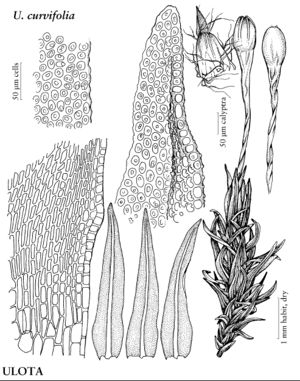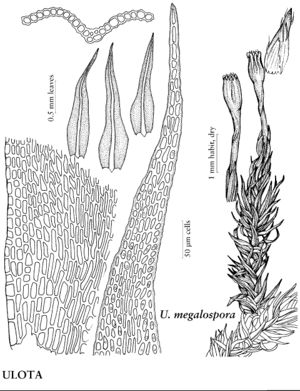Ulota
Ann. Bot. (König & Sims) 2: 540. 1806.
| Taxon | Illustrator ⠉ | |
|---|---|---|
 | Ulota crispa | Patricia M. Eckel |
 | Ulota curvifolia | Patricia M. Eckel |
 | Ulota megalospora | Patricia M. Eckel |
| ... further results | ||
Plants small to medium-sized, in tufts or loose cushions. Stems erect or rarely creeping, branches erect to ascending. Leaves straight and not crisped to flexuose and crisped when dry, erect-spreading to spreading-flexuose when moist, lanceolate, oblong-lanceolate, or linear-lanceolate, not rugose; margins entire; apex acuminate, acute, or narrowly obtuse; costa ending near apex or rarely excurrent; basal laminal cells roundedquadrate to elongate-rectangular or linear; distal cells hexagonal-rounded to elliptic, 6–14 µm, sometimes smooth, usually papillose only over lumina, papillae 1 (or 2) per cell, conic, 2-fid, or clavate; marginal cells abruptly shorter than basal. Sexual condition autoicous or rarely dioicous; perichaetial leaves larger than stem-leaves. Seta 1–10 mm. Capsule fully exserted, fusiform-cylindric, ovate-oblong, or rarely obovate, slightly 8-plicate at mouth to strongly 8-ribbed entire length or rarely smooth, mouth puckered or capsule ± constricted below mouth; stomata superficial; peristome double or single; exostome teeth 8, sometimes split to 16, finely and densely papillose to papillose-striate or rarely smooth; endostome segments 8 or absent. Calyptra mitrate, short to oblong-conic, base usually deeply split several times, smooth, hairy, not plicate, covering 1/2 capsule. Spores isosporous.
Distribution
North America, South America, Europe, Asia, Pacific Islands (New Zealand), Australia, temperate regions
Discussion
Species ca. 60 (9 in the flora).
Ecologically, Ulota is primarily found either in wet, shaded coniferous forests, particularly in areas of high rainfall, or in subalpine areas on small trees. Ulota is closely related to Orthotrichum. Ulota is distinguished from other genera by the conic calyptra, highly differentiated basal laminal cells, crisped leaves, superficial stomata, and lack of gemmae on the leaves. The leaf base is usually ovate and clasping the stem; the interior basal laminal cells radiate from the insertion and are thick-walled, often nodose, and usually orange; the capsule is gradually contracted to the seta with a long neck; the prostome is absent; the exostome teeth are more or less perforate at their apices; and the endostome segments are incurved. A few species show a close resemblance to Macromitrium in having creeping stems and similar basal cells and calyptrae. The North American species can be divided into four groups: dioicous species, producing gemmae (U. phyllantha); species with a single, erect-flexuose peristome and leaves not much crisped (U. coarctata and U. drummondii); species with a double peristome and exostome teeth reflexed (U. barclayi, U. crispa, U. curvifolia, U. hutchinsiae, and U. obtusiuscula); and species with creeping branched stems (U. megalospora).
Selected References
None.
Lower Taxa
Key
| 1 | Sexual condition dioicous; specialized asexual reproduction present on leaf apices; maritime habitats. | Ulota phyllantha |
| 1 | Sexual condition autoicous; specialized asexual reproduction absent; non-maritime habitats | > 2 |
| 2 | Capsules with mouth small, distinctly smaller at mouth than at middle; peristome single; exostome teeth erect, flexuose | > 3 |
| 2 | Capsules with mouth wide but constricted below mouth or evenly tapering to seta from mouth; peristome double; exostome teeth reflexed | > 4 |
| 3 | Capsules obovate to oblong-ovoid, puckered and slightly 8-plicate at mouth. | Ulota coarctata |
| 3 | Capsules cylindric to fusiform, 8-ribbed 1/2 -2/3 length. | Ulota drummondii |
| 4 | Perichaetial leaves differentiated from stem leaves. | Ulota barclayi |
| 4 | Perichaetial leaves not differentiated from stem leaves | > 5 |
| 5 | Stems both creeping and erect; leaf apices filiform-acuminate; leaves linear- lanceolate; stomata near mid capsule; spores 35-60 µm. | Ulota megalospora |
| 5 | Stems all erect; leaf apices acute or obtuse; leaves lanceolate or linear-lanceolate; stomata in capsule neck; spores 9-32 µm | > 6 |
| 6 | Leaves erect-appressed, not crisped or contorted when dry. | Ulota hutchinsiae |
| 6 | Leaves flexuose, crisped, or contorted when dry | > 7 |
| 7 | Plants on rock; leaves flexuose, not contorted or twisted when dry. | Ulota curvifolia |
| 7 | Plants on trees; leaves contorted, crisped, or twisted when dry | > 8 |
| 8 | Basal laminal cell walls thin, cells hexagonal-rounded, not pigmented; calyptrae sparsely hairy; leaves slightly crisped and curved when dry. | Ulota barclayi |
| 8 | Basal laminal cell walls thick, cells linear-elongate grading to quadrate at margins, pale yellow; calyptrae very hairy; leaves crisped-contorted when dry | > 9 |
| 9 | Plants to 2.5 cm; setae to 3 mm; capsules constricted below mouth; leaves crisped-contorted, not twisted when dry; e North America. | Ulota crispa |
| 9 | Plants to 4 cm; setae usually 4 mm or longer; capsules evenly tapering from mouth to seta; leaves contorted, some tightly twisted when dry; w North America. | Ulota obtusiuscula |